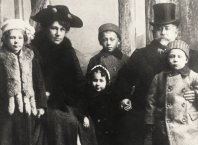History of the Jews in Lower Austria from the Beginnings until 1945
In 1938, Lower Austria was the Austrian federal province with the highest number of Jewish communities – it had 15 Israelite religious communities. Lower Austria did not only have communities in urban areas, but also contained large „rural parishes“ in the districts surrounding the towns. A number of regional papers have been published and some additional research has already been done regarding the history of the Jews in Lower Austria, especially covering the time of National Socialism; however, an extensive account of the history of the Jews of Lower Austria is still to be desired. The Institute is thus planning a 4-volume-series covering this topic over the next years; Volume IV has already been published.
Series in 4 Volumes, Mandelbaum publishers, Vienna
Information: |mail: Dr. Martha Keil|
Volume 1
From the Beginning to 1496
(Birgit Wiedl, Martha Keil)
This volume is in preperation. The collection of the sources is still work in progress. We ask for your patience.
This volume contains the legal, economic and social positions of Jews in mediaeval Austria as well as the religious and cultural community- and everyday-life in relation to the Christian environment. The sources included in the „Regesten zur Geschichte der Juden im Mittelalter“ – a project of the Austrian Science Fund (FWF) – will also be included as well as legal expertise and Minhagim (legal traditions and rites) of Austrian rabbis.
Volume 2
Barbara Staudinger, „Gantze Dörffer voll Juden“. Geschichte der Juden in Niederösterrecih 1496–1670. Wien 2005, Mandelbaum Verlag (Entire Villages full of Jews. History of the Jews in Lower Austria 1496–1670)
The history of the Jews of Lower Austria in the early modern age from the beginnings in the early 16th century to the expulsion from Vienna and Lower Austria 1670 has remained almost unnoticed. The author describes the slow phase of reconsolidation of Jewish life in Lower Austria, where the Jewish communities flourished in the last 50 years before the expulsion. The investigation is based on a study of sources and research of the project „Austria Judaica“ and for the first time offers a complete history of the long forgotten rural Jews.
|Further Information in German|
Volume 3/1
Christoph Lind, Kleine jüdische Kolonien. Geschichte der Juden in Niederösterreich 1782–1914. Wien 2013, Mandelbaum Verlag (Small jewish colonies. History of the Jews in Lower Austrai 1782–1914). For the time between 1782–1914, the author has worked on an integrate history of the Jewish communities in Lower Austria, taking political, cultural, religious, social and economic aspects into consideration.
|Further Information in German|
Volume 3/2
Christoph Lind, Geschichte der Juden in Niederösterreich 1914–1938 (History of the Jews in Lower Austria 1782–1914 – soon to be published)
For the time between 1914 and 1938 the author is working on an integrate history of the Jewish communities in Lower Austria, taking political, cultural, religious, social and economic aspects into consideration.
The debates of the IKG and the Jews of Lower Austria concerning anti-Semitism as well as the defence reactions of the communities are to be looked at in detail – especially as regards the repercussions. The First World War and its consequences for the Jewish community of this country are of great interest as is the situation of the Lower Austrian Jews in the time of political conflict during the First Republic and their relationship to the corporative state (era of Austro-Fascism) with the growing strength of National Socialism.
Volume 4
Christoph Lind, „Der letzte Jude hat den Tempel verlassen“. Juden in Niederösterreich 1938–1945. Wien 2004, Mandelbaum Verlag (The Last Jew has Left the Temple. Jews in Lower Austria 1938–1945)
The publication describes the Anschluss and the following pogrom, Aryanization and deportation, the November-pogrom of 1938 and finally the dissolution of the communities. In addition, the fate of the synagogues and cemeteries during the war and the post-war years is depicted. The book contains a register of the synagogues, temples, prayer rooms, Jewish cemeteries, rabbis and cantors as well as the Jewish associations and clubs in Lower Austria. The research was sponsored by the federal province of Lower Austria, department for Culture, and the National Fund of the Republic of Austria for Victims of National Socialism.
|Further Information in German|
We would like to express our thanks to Land Niederösterreich for its support of this project.
